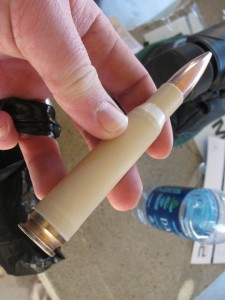The Firearms Blog has posted a bit about polymer cased ammunition. Check it out here.
At the last SHOT SHOW’s Media Range Day, I observed some of this.

I don’t remember the name of the company, but I believe they were either Utah or Idaho based. Cost savings is a big benefit, but the biggest boon is the weight savings. 30% reduction in the weight of a loaded cartridge. Now imagine the benefit of that when you are a soldier or sheepdog using Surefire’s quad stacked 60 or 100 round cases. Think that might be helpful? You bet it is. At the Media Range Day, I was also told that the cases are easily reloadable.

That’s nothing entirely new. At least 5 years ago there was polymer cased .223 (not 5.56) ammo sold at retail. The cases were different colors to coincide with the different projectile weight. It was only in 1 caliber that I was aware of, but it never really caught on. I should’ve picked up a few boxes now that I think of it just for the sake of owning “different” ammo. I would like to see how the big fifty performs though…just for giggles.
I remember there being some plastic-cased, hand-reloadable .38 special ammo back in the early 80s. Red plastic cases, if I recall correctly.
VERY low power. I never chronographed it, but I’d be surprised if it was over 600 fps.
I have a ton of the .38spl, and the problem is case separation in the cylinder. About 25% of the case tear loose either where the projectile is seated or down at the base. I figure I’ll just break it down and salvage the powder and projectile some day.
Also IIRC the first gen .223 worked kind of okay until you went FA, then the cases started melting in the chamber…ooops. I have some of those as well.
Polymers have come a long way since the 80’s.
I still have several hundred rounds of the .38 spl (158 grn. wad round wad cutter brass washed) plastic cased (white color) plastic ammo, loaders, boxes of slugs and the reloading hand tool as well as advertising materials. My step dad was a plastics whole saler and got STUFF at the plastics conventions as free samples (circa 1970’s) including six round boxes of “sample” loaded rounds, he would bring home to me cause he knew I had an interest. Boy those were the days huh? Free samples of loaded small arms rounds just take what you want off the table like they do pens now! Keep thinking I should do another article for Combat Handguns about the plastic rounds. NOT light loads really smart out of a LW .38 snub.
True dat, Ogre, ‘course IIRC my cost – back when I bought the stuff – for the .36spl was somewhere around $0.05/rd, so I’m still ahead of the game, heh, heh.
Biggest problem with polymere ammo is that it does not absorb heat very well. Chambers get hot, and you would be surprised how much heat is ejected out of the gun with a brass case. (If you’re a miltary guy whos ever made the mistake of touching a case ejected from an automatic weapon, you know exactally what i’m talking about.)
This is one of the reasons H&Ks G-11 caseless project failed: It got so hot that even with a ceramic plated chamber rounds would cook off. There was no way to rapidly expell heat from the firing mechanisims.
In response to Dave above this (and Ogre), polymers have come a long way since the 1980’s. The issue w/ the G11 was pre-ignition during sustained fire due to the nitro-cellulose case. I hole that a hybrid polymer/nitrocellulose case would probably solve the issue.